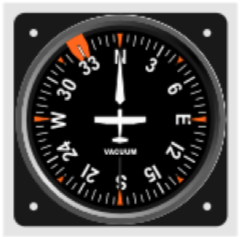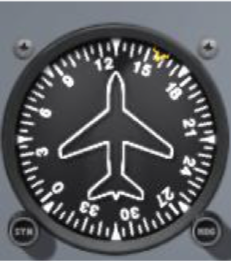¶ Mechanism
The gyro in the heading indicator is mounted in a vertical plane and depends upon rigidity in space for its operation. The aircraft symbol at the center of the instrument points on the aircraft heading.
The gyro may turn either via a vaccum pump (important to have a correct depression) or via an electric motor (important to have a correct voltage).
¶ Aspect
The heading indicator is used to inform the pilot of the aircraft's heading.
It is sometimes referred to by its older names, the directional gyro and also direction indicator.

¶ Use
The heading indicator is fundamentally a mechanical instrument designed to facilitate the use of the magnetic compass. Errors in the magnetic compass are numerous, making straight flight and precision turns to headings difficult to accomplish, particularly in turbulent air.
To remedy errors in the magnetic compass reading, the pilot will typically manoeuvre the airplane with reference to the heading indicator, as the gyroscopic heading indicator is unaffected by dip and acceleration errors.
The primary means of establishing the heading in most small aircraft is the magnetic compass, which, however, suffers from several types of errors, including that created by the "dip" or downward slope of the Earth's magnetic field. Dip whenever the aircraft is in a bank, or during acceleration, making it difficult to use in any flight condition other than perfectly straight and level.
The pilot will periodically reset the heading indicator to the heading shown on the magnetic compass.

- None
- VID 150259 - Creation
- VID 450012 - Update
- VID 496402 - Wiki.js integration